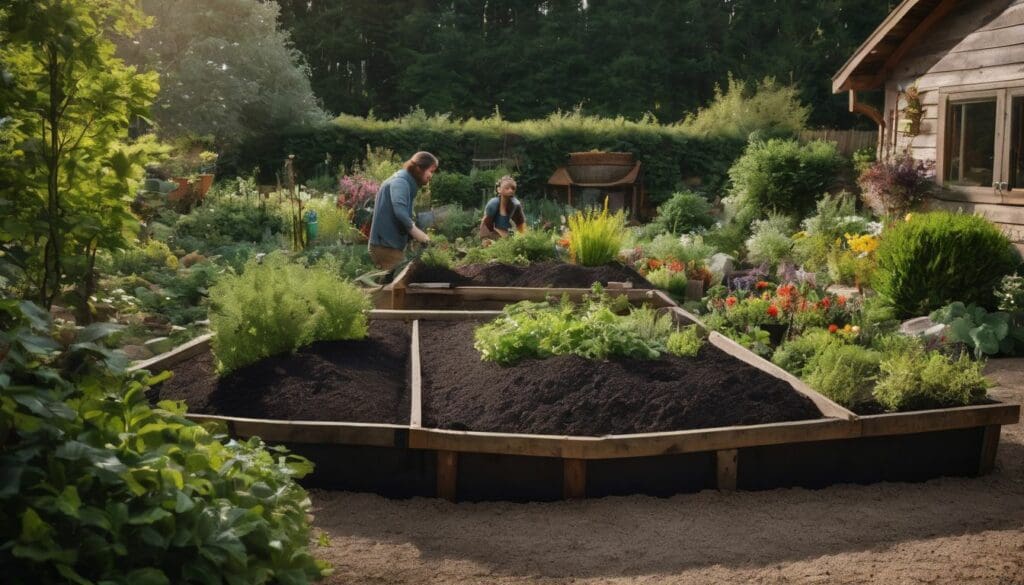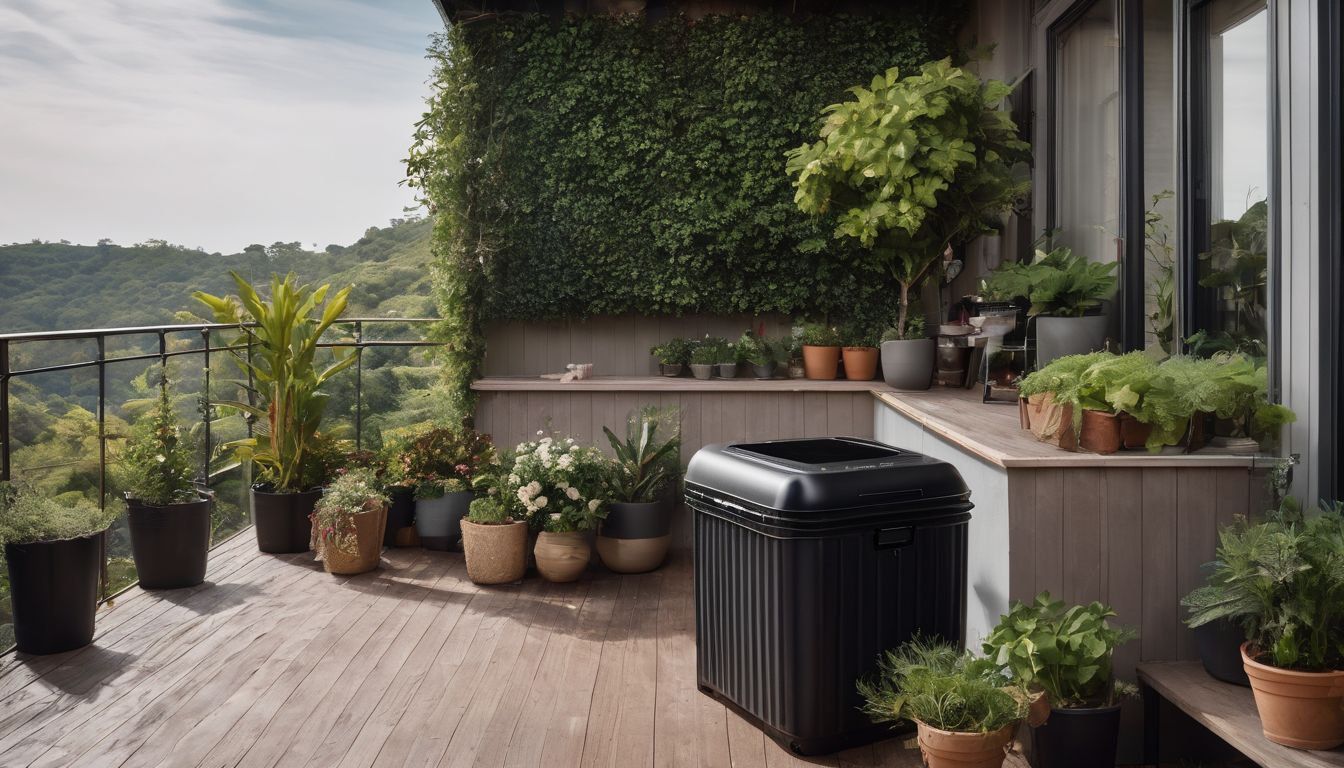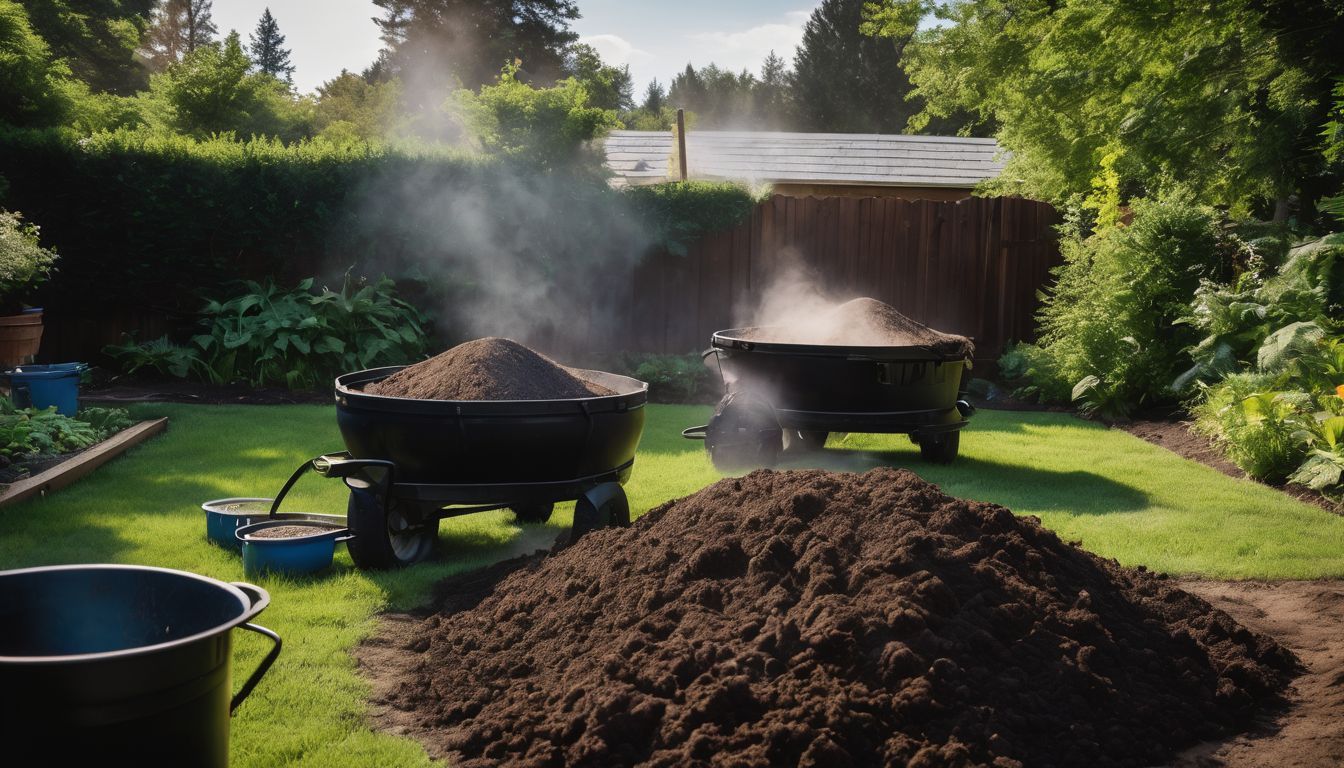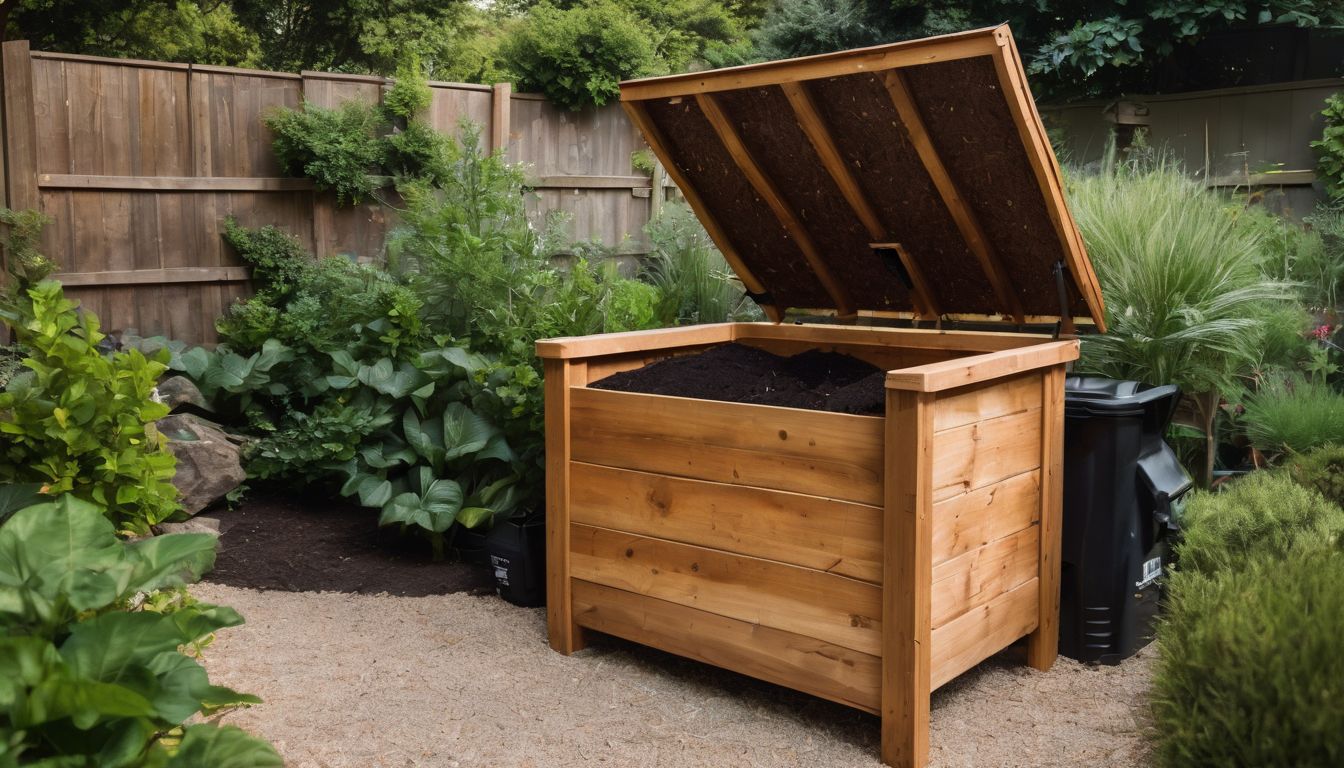Are you staring at a pile of finished compost, wondering how to give your garden that extra boost? Compost is a powerhouse for enriching soil with nutrients essential for plant growth.
This blog will guide you through simple steps to transform your garden using this ‘black gold.’ Let’s dig in and make your garden thrive!
Key Takeaways
- Mix finished compost into your garden’s soil to boost nutrient content and improve plant health.
- Create your own potting mix or compost tea using finished compost for an eco – friendly gardening solution.
- Apply a layer of finished compost as mulch to conserve moisture and suppress weeds naturally in the garden.
- Add finished compost to new or existing garden beds, enhancing soil structure for robust plant growth.
- Incorporate compost into potting mixtures for potted plants, providing them with rich nutrients.
What is Finished Compost and its Benefits for the Garden
Finished compost is the end product of efficient and consistent composting, providing a nutrient-rich soil amendment for your garden. It can be used to make DIY potting mix, compost tea, and also serves as mulch to feed the soil and prevent drying out.
Efficient and consistent composting
Efficient and consistent composting transforms kitchen scraps and garden waste into a nutrient-rich soil amendment, elevating your organic gardening to new heights. By maintaining a balanced mix of green and brown materials, turning the heap regularly, and ensuring adequate moisture, you create an environment where beneficial microbes thrive.
This process speeds up decomposition, delivering usable compost faster.
Mastering these techniques requires patience but pays off with sustainable gardening benefits. Use your homemade compost to boost soil health, support plant growth with vital nutrients, and contribute to conservation efforts through waste reduction.
Your plants will thank you with abundant growth as they draw sustenance from the natural fertiliser provided by your well-tended compost pile.
Tells us when compost is ready
After efficient and consistent composting, it’s essential to know when compost is ready for use in your garden. A simple test includes checking if the compost is dark brown, crumbly, and has an earthy smell – indicating that it’s fully decomposed and ready for application.
Keep an eye out for any remaining materials that haven’t broken down completely. With this readiness indicator, you can confidently employ your nutrient-rich finished compost to enrich your garden soil and enhance plant growth without any concerns about its maturity.
Utilising finished compost at the right time ensures maximum benefits to your plants while supporting sustainable gardening practices. Screening the finished product helps eliminate any potential contaminants or large pieces of organic matter before storing it for future use.
Screening and storing compost
Once your compost is ready, the next step is to screen and store it properly. Screening the compost helps to remove any large chunks or debris, leaving you with a fine, consistent texture that’s easy to work with.
Storing your finished compost in a dry, covered area will help preserve its nutrient-rich qualities for when you’re ready to use it in your garden. It’s important to ensure proper airflow during storage to prevent excessive moisture buildup and maintain the quality of your compost.
When storing compost, make sure that it is kept in a location that allows for air circulation but protects from heavy rain or excessive moisture. This will help preserve the valuable nutrients until you’re ready to incorporate it into your garden beds or potting mixtures.
Making DIY potting mix and compost tea
To create your own potting mix and compost tea, you can use finished compost from your garden. This provides a nutrient-rich and eco-friendly alternative to shop-bought products. Here’s how you can do it:
- Create a DIY potting mix by blending finished compost with equal parts peat moss or coconut coir and perlite or vermiculite to provide a well-draining and nutrient-rich medium for your potted plants.
- Brew compost tea by placing finished compost in a porous bag or container, submerging it in water, then aerating the mixture for 24-48 hours to create a nutrient-rich liquid fertiliser for your garden.
- Use the homemade potting mix and compost tea to enhance the health and vitality of your potted plants while reducing reliance on commercial products that may contain harmful chemicals.
Using compost as mulch
After making DIY potting mix and compost tea, utilising finished compost as mulch in your garden is an effective way to enhance soil quality and nourish plants. Applying a layer of compost as mulch helps to feed the soil, improve moisture retention, and suppress weed growth.
By using compost as mulch, you can ensure that the nutrients are slowly released into the soil, providing long-term benefits for your garden.
Additionally, using compost as mulch creates a healthy ecosystem for beneficial microorganisms and earthworms to thrive, further enriching the soil. This technique supports conservation efforts by reducing the need for chemical fertilisers and promoting sustainable gardening practices that benefit both plants and the environment.
Using Compost in New Garden Beds
When starting a new garden bed, simply add a 3-4 inch layer of finished compost to the soil surface. This will help enrich the soil and provide essential nutrients for plant growth.
Adding 3-4 inch layer to soil surface
Spread a 3-4 inch layer of finished compost over the soil surface, enriching it with essential nutrients and organic matter. This aids in retaining moisture, suppressing weed growth, and encouraging beneficial microbial activity.
The added compost enhances soil structure, promotes healthy root development, and supports overall plant growth while minimising the need for chemical fertilisers.
By incorporating this nutrient-rich layer into your garden beds, you are investing in sustainable gardening practices that nourish the earth and promote environmental health.
Incorporating other amendments as needed
When incorporating finished compost into garden beds, it is essential to consider other amendments as needed. This may include adding lime to raise the pH level of acidic soil or sulfur for alkaline soil.
Additionally, you might want to incorporate organic matter like peat moss or coconut coir to improve moisture retention in sandy soils.
To promote a healthy and balanced garden ecosystem, it’s important to assess the specific needs of your plants and soil before adding finished compost. Conduct a soil test if necessary, and make adjustments based on the results using natural and organic materials whenever possible.
Incorporating Compost in Existing Garden Beds
Mix the finished compost with the native soil when planting trees, shrubs, and perennials. Side-dress nitrogen-loving plants with compost to promote healthy growth and strong root development.
Mixing with native soil when planting trees, shrubs and perennials
Incorporate finished compost into the native soil when planting trees, shrubs, and perennials. Break up the planting area and mix the compost thoroughly with the native soil. This will improve moisture retention, nutrient availability, and overall soil structure.
Ensure that the roots of the plants come into direct contact with this nutrient-rich mixture for optimal growth and establishment.
When incorporating finished compost into native soil, ensure an even distribution throughout the entire planting area. Take care not to compact the amended soil excessively as it can restrict root development.
Side-dressing nitrogen-loving plants
To side-dress nitrogen-loving plants, sprinkle a layer of finished compost around the base of each plant. Gently work the compost into the soil without disturbing the plant roots to provide a slow-release of nutrients as the plants grow.
This helps maintain optimal nutrient levels for vigorous growth, blooming, and fruit development.
This method encourages healthy root development while preventing excessive vegetative growth and increasing resistance to pests and diseases. It also reduces nutrient runoff, benefiting both your garden and the environment by minimising chemical fertiliser use.
Using Compost for Potted Plants
Incorporate compost into potting mix for potted plants. Brew compost tea to water and feed your container garden.
Adding to potting mix
Mix finished compost with potting soil to create a nutrient-rich blend for potted plants. Use a 1:1 ratio of compost to potting mix, ensuring even distribution of the mixture. The addition of compost enhances soil structure and increases water retention, benefiting plant growth and health.
Amend your regular potting mix by adding finished compost before repotting or planting new seeds. This creates an optimum environment for root development and overall plant vitality.
Incorporate this enriched soil into your gardening routine for healthier, more vibrant potted plants year-round.
Brewing compost tea
Brewing compost tea can provide a nutrient-rich liquid fertiliser for your garden. Begin by placing finished compost in a porous container, such as a burlap sack or old pillowcase.
Fill the container with water and let it steep for 2-3 days, stirring occasionally. Afterwards, strain out any solid materials and use the resulting liquid to water your plants or foliar feed them.
This natural brew will help improve soil quality and promote healthy plant growth.
To make compost tea, place finished compost in a permeable container like a cloth bag or mesh basket. Add water and allow it to soak for 2-3 days while stirring occasionally. Afterward, filter out any solids and apply the liquid as needed to nourish your plants’ roots directly or as foliage spray.
Tips for How to Use Compost in Your Garden
– Applying finished compost in early spring or fall can help enrich the soil and provide key nutrients for your plants.
– Using finished compost as mulch can help feed the soil and prevent it from drying out, while also acting as a top dressing throughout the year.
Applying in early spring or fall
In early spring or fall, apply finished compost to your garden beds. This helps enrich the soil with nutrients essential for plant growth, and also aids in moisture retention during the upcoming growing season.
By incorporating compost at these times, you ensure that the organic matter has time to break down and release its beneficial components into the soil before plants require them for vigorous growth.
To enhance your garden’s vitality, consider applying finished compost in early spring or fall as part of your regular gardening routine.
Using as mulch to feed soil and prevent drying out
Applying finished compost as mulch enriches soil, retains moisture, and prevents weed growth. The nutrient-rich compost acts as a protective layer over the soil, nourishing plants while reducing water evaporation.
This sustainable gardening practice supports conservation efforts by minimising water usage and promoting healthy plant growth.
Organic mulching with finished compost aligns with environmentally conscious gardening practices. It fosters soil health, reduces the need for synthetic fertilisers, and encourages a thriving ecosystem within the garden.
As an active participant in environmental stewardship, incorporating compost as mulch enhances both the aesthetic appeal and sustainability of your garden.
Using as a top dressing throughout the year
To maintain soil health and provide ongoing nourishment, consider using finished compost as a top dressing throughout the year. By layering a thin blanket of compost over your garden beds, you can continually replenish essential nutrients and organic matter.
This approach helps to improve soil structure, retain moisture, suppress weeds naturally, and enhance microbial activity in the soil. Top dressing with compost also supports beneficial earthworms and other organisms crucial for healthy plant growth.
Moreover, applying compost as a top dressing provides a slow-release method of feeding your garden plants while reducing the need for synthetic fertilisers. The continuous addition of compost enriches the soil gradually and promotes long-term sustainability within your garden ecosystem.
Adding directly to garden beds
To enrich garden beds, add finished compost directly to the soil surface. Spread a 3-4 inch layer over the garden bed and gently work it into the top few inches of soil using a rake or hoe.
This method improves soil structure, increases water retention, and enhances nutrient levels for healthy plant growth without causing damage to delicate root systems.
Moving on to “Incorporating into soil at planting time,” let’s explore how to ensure your new plants get the best start possible.
Incorporating into soil at planting time
When adding finished compost directly to garden beds, incorporating it into the soil at planting time is essential for optimal plant growth. By mixing compost with native soil during planting, you ensure that the roots have immediate access to vital nutrients and a healthy environment for establishment.
This process enriches the soil, supporting long-term plant health and vitality.
Incorporating compost into the soil at planting time benefits your garden by providing an immediate source of organic matter and nutrients. As you prepare the soil for new plants, mix in finished compost to enhance its structure, water retention, and fertility.
Conclusion
Enhance your garden’s health by using finished compost. Incorporate a 3-4 inch layer into new soil for nourishment. Mix it with native soil when planting trees and shrubs for best results.
Use compost as mulch to feed the soil and prevent drying out. Apply directly to garden beds or incorporate into the soil at planting time for optimal plant growth.
FAQs
1. What are the benefits of using finished compost in my garden?
Using finished compost enriches your garden soil with nutrients, improves soil quality, and helps plant growth, making your garden thrive.
2. How do I apply compost to my garden beds?
You can incorporate compost into your garden beds by spreading it on top of the soil or mixing it in to help with plant feeding and soil enrichment.
3. What is mulching and how can I use compost for it?
Mulching means covering the soil around plants with materials like compost to maintain moisture levels; simply spread a layer of your finished compost around the plants.
4. Can I make something like a tea with my finished compost?
Yes! You can brew a nutrient-rich “compost tea” by soaking some of the finished material in water, then use this liquid to feed your plants gently.
5. Are there any tips for applying compost in different parts of my garden?
Definitely! For healthier growth, utilise techniques such as adding a layer when planting new seedlings or blending it into existing flowerbeds; each technique varies depending on where you’re applying it in your gardening practices.





